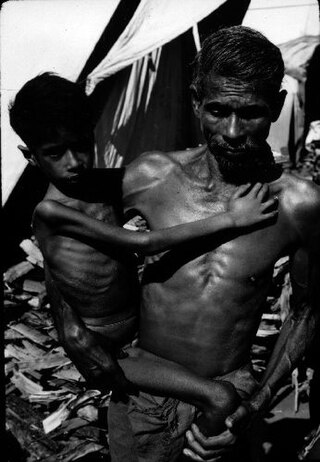Marasmus
Marasmus is a form of malnutrition. It happens in people (especially children) who do not get enough food. A healthy person gets energy from eating food, especially foods with protein and fat in them. Because a person with marasmus is not getting enough food, they do not get the energy they need to survive. This is due to deficiency of both proteins and calories. Generally, this disease when there is an immediate second pregnancy or repeated child births. Lean and weak, swelling limbs, less developed muscles, dry skin, diarrhoea, etc.., are the symptoms of this disease.
| Marasmus | |
|---|---|
| Classification and external resources | |
 Child suffering with Marasmus in India, 1972 | |
| ICD-10 | E41.-E42. |
| ICD-9 | 261 |
| DiseasesDB | 7826 |
| eMedicine | ped/164 |
| MeSH | D011502 |
Children with marasmus look emaciated (very skinny). This is because their bodies have burned up all of their fat and muscles to make energy. The child's body weight will be less than 60% of a normal child his or her age.[1]
Marasmus can be treated. However, about half of children with bad malnutrition die because they cannot get treatment where they live.[2]
The word “marasmus” comes from the Greek word μαρασμός marasmos (meaning "decay '')
Signs and symptoms
Most children with marasmus look shrunken and have lost most of their muscles and body fat.[3] Their bodies try to save as much energy as possible by shutting down the immune system, not growing, and giving less energy to the liver, kidneys, heart, and gastrointestinal system.[4] This can cause problems like:[4]
- Having too much fluid in the body, because the kidneys are not working well enough to get rid of it. This can lead toedema (fluid under the skin) and even heart failure.
- Hypothermia (low body temperature), because staying warm takes energy, and because the child has almost no fat or muscles to keep them warm
- Hypoglycemia (low blood sugar), because the child is not getting sugar or carbohydrates from foods
- Infection, because the child's body has shut down the immune system, which usually fights infection, to save energy
Other symptoms of marasmus include:[5]
- Anemia (not having enough red blood cells in the blood)
- Dehydration, not having enough water in the body
- Shock caused by dehydration (hypovolemic shock)
- Tachypnea (breathing too fast - for example, from pneumonia or heart failure)
Causes
Marasmus is caused by a deficiency (not having enough) of nearly all nutrients, especially protein, carbohydrates, and lipids (fats).[4]
Treatment
Marasmus can be treated by giving emergency nutrients and fluids. However, treating the causes of marasmus is not enough. Often, the disease has complications (it causes other problems), like infections, dehydration, and problems with the circulatory system. These complications are very dangerous and often kill children if they are not treated correctly.[5]
Related pages
- Malnutrition
- Starvation
- Kwashiorkor (a similar disease caused by not having enough protein)
References
- ↑ Appleton, Amber; Vanbergen, Olivia (2013). Crash Course: Metabolism and Nutrition. London: Moseby. p. 130. ISBN 9780723438533.
- ↑ Badaloo AV, Forrester T, et al. 2006. "Lipid kinetic differences between children with kwashiorkor and those with marasmus". Am. J. Clin. Nutr. 83 (6): 1283–8. PMID 16762938.
{{cite journal}}: CS1 maint: multiple names: authors list (link) - ↑ Rabinowitz, Simon. "MD, PhD, FAAP". Emedicine Medscape. Medscape. p. 28. Retrieved 29 January 2015.
- ↑ 4.0 4.1 4.2 "Acute Malnutrition: Marasmus (or Wasting)". Harmonized Training Package: Resource Material for Training on Nutrition in Emergencies. UNICEF. Archived from the original on December 19, 2015. Retrieved January 28, 2016.
- ↑ 5.0 5.1 Bain LE, Awah PK et al. 2013. "Malnutrition in Sub-Saharan Africa: Burden, causes, and prospects". Pan African Medical Journal. 15 (1). doi:10.11604/pamj.2013.15.120.2535. Retrieved January 28, 2016.
{{cite journal}}: CS1 maint: uses authors parameter (link) - ↑ "Mortality and Burden of Disease Estimates for WHO Member States in 2002" (xls). World Health Organization. 2002.